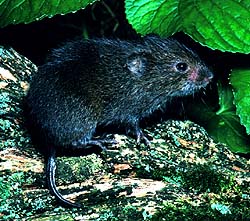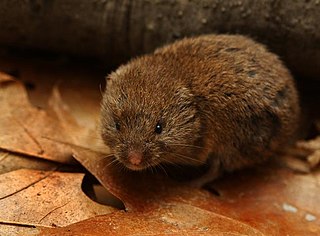
Voles are small rodents that are relatives of lemmings and hamsters, but with a stouter body; a longer, hairy tail; a slightly rounder head; smaller eyes and ears; and differently formed molars. They are sometimes known as meadow mice or field mice in North America.

The Arvicolinae are a subfamily of rodents that includes the voles, lemmings, and muskrats. They are most closely related to the other subfamilies in the Cricetidae. Some authorities place the subfamily Arvicolinae in the family Muridae along with all other members of the superfamily Muroidea. Some refer to the subfamily as the Microtinae or rank the taxon as a full family, the Arvicolidae.

The plateau vole is a species of rodent in the family Cricetidae. It was originally listed as Lasiopodomys, but was moved to Neodon in 2012. It is found only in China. Its natural habitat is temperate grassland.
The Chinese scrub vole, or Irene's mountain vole, is a species of rodent in the family Cricetidae. It is endemic to mountainous parts of southern China and is very similar to the Sikkim mountain vole in appearance. The International Union for Conservation of Nature has assessed its conservation status as being of "least concern".
The juniper vole is a species of rodent in the family Cricetidae. It is found in Afghanistan, China, Pakistan and Tajikistan. It was formerly classified in the genus Neodon, but genetic evidence indicates that it is classified within the subgenus Blanfordimys in Microtus.

Blyth's vole is a species of rodent in the family Cricetidae. It was previously the only species in the genus Phaiomys, but was moved to Neodon in 2016. It is found in mountainous regions in northern India, Nepal and China. It is a burrowing rodent and lives in small colonies. It has a wide distribution and faces no particular threats so the International Union for Conservation of Nature has assessed its conservation status as being of "least concern".
The Sikkim mountain vole is a species of rodent in the family Cricetidae. It is found in Bhutan, India, Nepal and China.

Clarke's vole is a species of rodent in the family Cricetidae. It is found only in China.
Neodon is a genus of rodent in the family Cricetidae. Species within Neodon are classified as relics of the Pleistocene epoch because the occlusal patterns resemble the extinct Allophaiomys.

Forrest's mountain vole is a species of rodent in the family Cricetidae found within China in northwest Yunnan. The initial study by Hinton in 1923 identified it as morphologically close to the Chinese scrub vole but with a larger body size and longer and darker pelage.
The Linzhi mountain vole is a species of rodent in the family Cricetidae. It is endemic to mountainous parts of southern China.

Microtini is a tribe of voles in the subfamily Arvicolinae.
The Shergyla mountain vole is a species of rodent in the family Cricetidae. It is found only in China.
The Namchabarwa mountain vole is a species of rodent in the family Cricetidae. It is found only in China.
Liao Rui's mountain vole is a species of rodent in the family Cricetidae. It is found only in China.
The Chayu mountain vole is a species of rodent in the family Cricetidae. It is found only in China.
The Bomi mountain vole is a species of rodent in the family Cricetidae. It is found only in China.
The Bershula mountain vole is a species of rodent in the family Cricetidae. It is found only in China.
The Nyalam mountain vole is a species of rodent in the family Cricetidae. It is found only in China.
The Nepalese mountain vole is a species of rodent in the family Cricetidae. It is found only in China.






